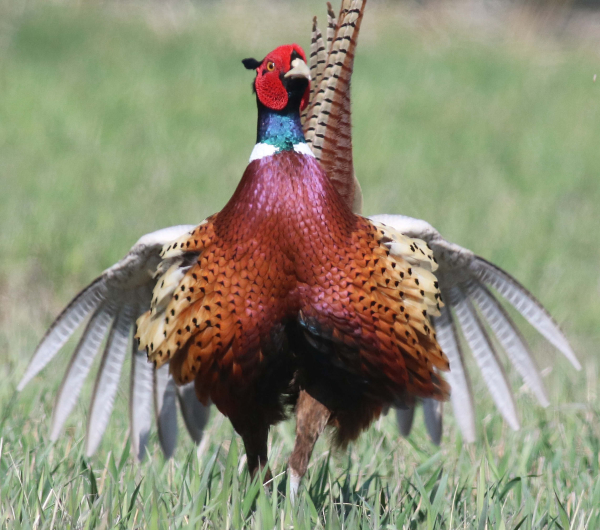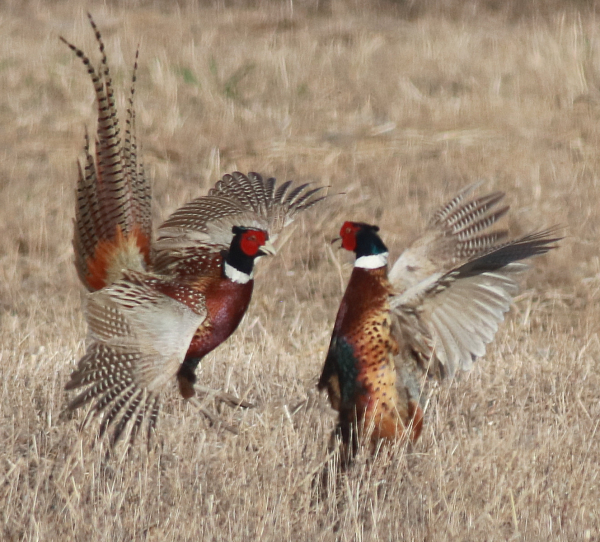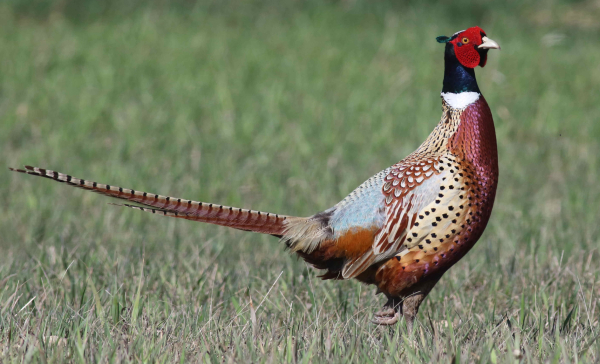
I’ve lived around pheasants most of my life; if you live within their range, pheasants are among the first birds you notice, can identify, and get excited about. They are fairly large and the males are gaudy in color and form. Females are equal in form and especially beautiful when you develop an appreciation for the intricacies of their detailed plumage. Ring-necked Pheasants tend to be fairly wary birds, mostly encountered in rural settings, and they do not migrate, so provide photo fodder throughout the seasons.
With the first day of spring approaching, a variety of photo opportunities will arise, with the males trying their best to attract and court one or more females through acts of crowing, stunning displays, an occasional fight among males, and chases; all are all action-packed opportunities for us to photograph pheasants at their best.
|
Facing directly at the photographer (Paul), the crowing display lasted just a moment, but provided a series of photos that revealed the details of its spirited movements 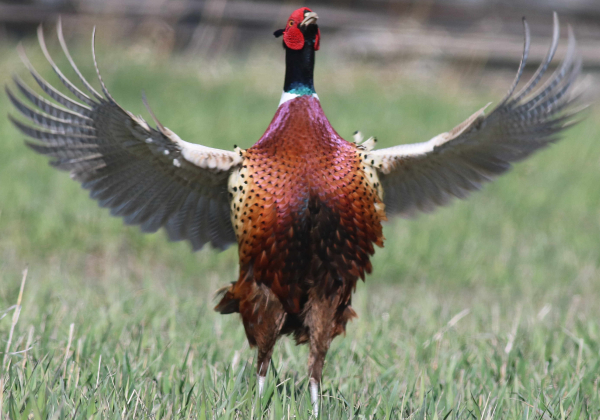 Filled with great spirit and excitement, the pheasant performed an instinctive behavioral display that generations of Ring-necked Pheasants have produced over millennia.
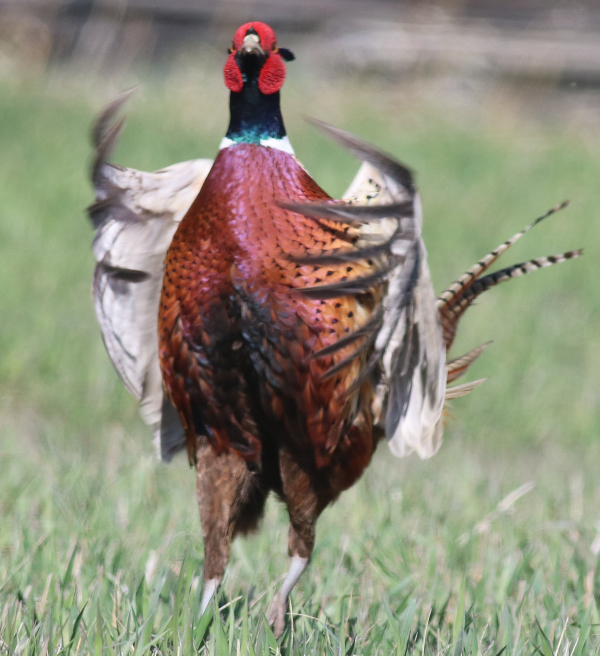 The luck of being in position to photograph the pheasant while the direction and intensity of the sunlight was prime, then to have it turn and erupt into voice and action provided a thrilling surprise. |
One thing that you immediately become aware of when you focus on a pheasant, their tail increases their size by twice, making them mostly horizontal subjects. Certainly, their tail provides a level of elegance that few birds possess, especially when tipped high in excitement. If the pheasant has its tail fanned out, when displaying, crowing, or as it lands at the end of a flight. You will also notice that it becomes ever harder to fit the whole tail into a photo frame, as you get closer to the pheasant, or as it gets closer to you. The bottom line is that when you are photographing pheasants, while we tend to be most aware of the bird’s head and body, pay special attention to its tail too.
The Crowing Prize
The ultimate pheasant photos must be of a rooster crowing. They should begin any day now up this way, and if you live in a lower latitude, pheasants may already be announcing their position by crowing. But hearing a rooster pheasant crow, and seeing one crow, are 2 entirely different things – and photographing the action of a crowing pheasant is almost impossible – almost.
For me, photographing a crowing pheasant provides the ultimate pheasant photo, or better yet, photo series; because crowing is not a one-step process. It is actually a momentary action in which the pompous male is so jazzed up on hormones it rises to its full height and throws its head and neck back while simultaneously elevating and spreading its tail. In unison it extends its wings back and sweeps them quickly forward as it belts out its best crowing notes, sweeping its head forward in the process. As it pulls its head back it flaps its wings forward again, which is audible if you’re reasonably close. It takes a moment for the engaging pheasant to regain its composure, only to take a few measured strutting steps as its most colorful plumage shines at its best.
It's the ultimate photo opportunity, but being in the right place at the right time with the pheasant turned in just the right way can be one of the hardest things to attain, and for your framing, camera tech, and fine sunlight all to gel, it can be a lifelong goal. When you are able to get the photo or a series of photos of the crowing process, the photos provide a level of elation that is not often matched for bird photographers. And that’s when your goal changes to photographing the crowing display again.
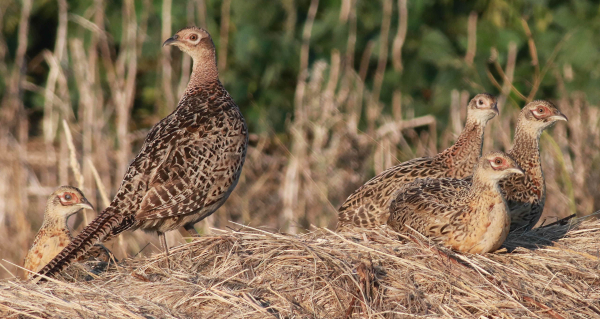
Feasant Fight
Second to photographing a colorful cock crowing, I’ve always hoped to photograph a spirited fight between Ring-necks. I see a good pheasant fight at least once each spring, but again, seeing one is rare, photographing it is astronomically difficult. But everyone gets lucky once in a while, and I had pretty good luck photographing an especially spirited and long-winded sparring fight a couple years ago when I least expected it. I was actually photographing Yellow-headed Blackbirds displaying on territory on the edge of a shallow marsh when I heard the sound of the wings as the pheasants fought out of sight.
|
Pheasant Fight! The opportunity to witness the action between 2 determined males is exciting to witness, and unforgettable to be in the right position to photograph the interactions. 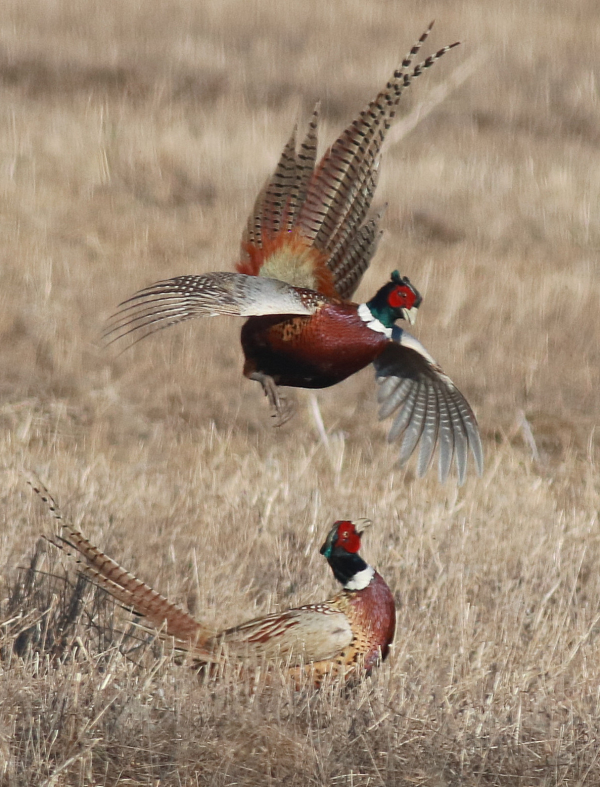 A fast shutter speed, wide aperture, and a degree of anticipation are important when you find pheasants sparring before you. |
I carefully pulled forward with my mobile blind, until a pheasant ran out from behind some low willows with another rooster running in close pursuit. They stopped in the open and faced off with their heads held low to the ground – then erupted into the air with their heads high, their wings flapping, their legs kicking, and their tails spread. They would stop a moment, then spar again; rest, then resume, and the fight continued in earnest for 17 minutes! It was a thrill to watch and photograph, and I couldn’t have been luckier than to have ample sunlight from behind me illuminating the fighting cocks before me. Plus, this was the longest feasant fight I’ve ever witnessed or heard about. This rare event left me with a good selection of photos to piece together into an exciting series of photographs illustrating this rite of spring.
Pheasant Flight
Seemingly equally difficult to photograph is a Ring-necked Pheasant in flight. The easiest way of getting a flight photo is to take a photo of one taking off or in the initial flaps of a flight. Of course, you don’t want to force a bird to fly, but they take off on their own accord all the time, so it’s a matter of keeping alert. Even so, mark my words, it’s almost as hard to get a quality photograph a pheasant in flight as it is to get a photo of a crowing pheasant or fighting roosters. Essentially, it’s a matter of being aware and getting lucky, and over time opportunities should arise.
Last spring while I was trying out a new camera lens, from behind me I heard the alert call of a pheasant, one sometimes produced as a bird takes flight. I turned as best I could to look behind me, only to see the pheasant flying quickly in my direction, parallel to my position. I managed to focus on the pheasant and took a series of 3 photos, 1 of which turned out to be my best photo of a Ring-necked Pheasant in flight with its cattail habitat in the background.
Of course, when you have subjects as impressive as Ring-necked Pheasants, any sharp photo of a female or male in an opening can be impressive and a matter of personal pride. I’m lucky enough to live in the midst of one of the strongholds for pheasants, near the border that divides the Dakotas, and an obvious indicator of how abundant pheasants are in the region is that Ring-necked Pheasants are the state bird of South Dakota. If pheasants are common or uncommon in your area, consider yourself lucky when you have a chance to photograph pheasants this spring, and anytime. The first of March marks the start of meteorological spring, so consider using that event as incentive to search for your next bird photography opportunity.
Addendum: Tuesday as I was putting the finishing touches on this issue of The Birding Wire, a beautiful female Ring-necked Pheasant spent most of the afternoon within sight of my bay windows as she foraged and rested, foraged and rested some more. She didn’t come to my feeding station, but she was only 50 feet away – gracias mi amiga.
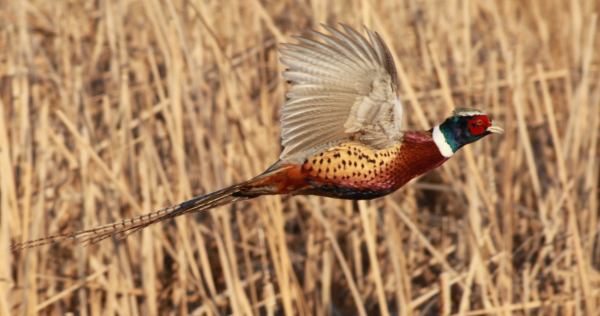
Article and photographs by Paul Konrad
Share your bird photos and birding experiences at editorstbw2@gmail.com

